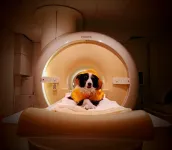(Press-News.org) INDIANAPOLIS—Indiana University researchers are collaborating on a novel approach to use neuroimaging and network modeling tools—previously developed to analyze brains of patients in the clinic—to investigate Alzheimer’s disease progression in preclinical animal models.
The research team, led by Evgeny Chumin, PhD, a postdoctoral research fellow in the College of Arts and Sciences' Department of Psychological and Brain Sciences at IU Bloomington, and Paul Territo, PhD, professor of medicine at the IU School of Medicine, published their findings in Alzheimer’s & Dementia: The Journal of the Alzheimer’s Association.
More than 6.5 million Americans ages 65 and older are living with Alzheimer’s disease, and that number could grow to nearly 14 million by 2060, according to the Alzheimer’s Association. While amyloid plaques and tau tangles are the two major hallmarks of Alzheimer’s disease, research studies also indicate that Alzheimer’s disease alters glucose metabolism in the brain.
Evgeny Chumin, PhD
This study looked at metabolic network changes in the brains of Alzheimer’s disease animal models developed by the Model Organism Development and Evaluation for Late-Onset Alzheimer’s Disease (MODEL-AD), a consortium of experts at the IU School of Medicine, Jackson Laboratory, University of Pittsburgh and Sage Bionetworks. The tools developed through this research collaboration, Territo said, provide a translational approach to assess disease progression of Alzheimer’s disease in animal models and bolster the consortium’s rigorous animal model development and preclinical drug testing pipelines developed to study and treat the disease.
“We now for the first time have created tools to assess mouse models carrying human genes, which are built upon the well-established Brain Connectivity Toolbox used in human studies,” Territo said. “We are applying these tools to better understand Alzheimer’s disease progression and therapeutic response and are embedding them as a resource in MODEL-AD.”
Territo, a primary member of IU School of Medicine’s Stark Neurosciences Research Institute and co-principal investigator of the MODEL-AD consortium, said two past studies inspired his research into analyzing how different areas of the brain interact during disease progression.
Olaf Sporns, PhD, a Distinguished Professor in the Department of Psychological and Brain Sciences at IU Bloomington, has previously published papers about network neuroscience, an approach for monitoring disease progression using graph theory and medical imaging—MRI and PET—to map, record, analyze and model the elements and interactions of neurobiological systems in humans. This allows scientists to see changes that occur in the brain’s subnetworks by elevating how neuroimaging like MRI and PET can be analyzed. Chumin is a postdoctoral researcher in the Sporns laboratory.
Metabolic covariance networks of Alzheimer’s disease animal models showed a lower community structure agreement compared to normal models. Agreement quantifies the propensity of regions in the metabolic network to cluster together, with lower values indicative of disruptions in inter-regional relationships of metabolic activity.
The other research is from Mattia Veronese, PhD, a scientist from King’s College in London and associate professor at the University of Padua in Italy, who studied human PET imaging data of participants of the Alzheimer’s Disease Neuroimaging Initiative (ADNI) to look for brain network changes and disease progression using the network neuroscience approach developed by Sporns. Veronese is also a co-author on the Alzheimer’s & Dementia journal article.
“Those two pieces of work led our team to develop tools that would extract additional meaning from images of MODEL-AD mouse models, with the goal of not only providing similar whole brain metrics observed in the previous clinical studies, but to also dive deeper and possibly understand how subnetworks within the brain of these models might shed light on the mechanisms of the underlying biology,” Territo said.
Chumin helped develop the tools and resources from the network neuroscience approach of human clinical research to preclinical animal models of MODEL-AD. The investigators analyzed the brain as a whole and also looked at subnetworks within the brain to see how those areas communicate and interact as the disease progresses.
“Using this approach, the research team’s analysis of metabolism changes in animal models confirmed previous clinical findings of disease progression in patients with Alzheimer’s disease,” Territo said.
The animal models showed age-related changes in glucose uptake as well as differences between males and females—similar to findings from Alzheimer’s disease human data.
Territo said MODEL-AD plans to use these network neuroscience tools in their investigations of other preclinical data, including models of late-onset Alzheimer’s disease, potential therapeutics for the disease and multi-modal analyses that combine neuroimaging data from PET and MRI.
About IU School of Medicine
IU School of Medicine is the largest medical school in the U.S. and is annually ranked among the top medical schools in the nation by U.S. News & World Report. The school offers high-quality medical education, access to leading medical research and rich campus life in nine Indiana cities, including rural and urban locations consistently recognized for livability.
END
IU researchers develop new brain network modeling tools to advance Alzheimer's disease research
2023-11-30
ELSE PRESS RELEASES FROM THIS DATE:
Sea fireflies synchronize their sparkle to seek soulmates
2023-11-30
ITHACA, N.Y. -- In sea fireflies’ underwater ballet, the males sway together in perfect, illuminated synchronization, basking in the glow of their secreted iridescent mucus.
“It’s extreme,” said Nicholai M. Hensley, a postdoctoral fellow in the Department of Neurobiology and Behavior in the College of Arts and Sciences. “It’s an illustration of convergent evolution and a striking example of synchronized bioluminescent mating displays. The males are putting it all out on the dance floor. It’s a big bright display.”
Hensley is the lead author of new research unwrapping the vivid mating ...
Structural racism persists in radiotherapy
2023-11-30
Philadelphia, November 30, 2023 – Everyone should get quality care, no matter the color of their skin. However, implicit bias, micro-aggressions, and a lack of cultural understanding persist, leading to oppression and unequal treatment in healthcare. An insightful article in the new themed issue of the Journal of Medical Imaging and Radiation Sciences on specialized populations, published by Elsevier, highlights this serious problem, specifically addressing the assessment and treatment of radiation-induced skin reactions (RISR) in patients across the world undergoing external beam radiotherapy.
The article provides a stark example ...
BU researcher receives K01 grant to study how nutrition impacts TB incidence, mortality
2023-11-30
(Boston)—Pranay Sinha, MD, assistant professor of medicine at Boston University Chobanian & Avedisian School of Medicine, has received a National Institutes of Health Mentored Research Scientist Development Award (K01). These awards provide support and protected time (three to five years) for an intensive, supervised, career development experience in the biomedical, behavioral or clinical sciences, leading to research independence.
As part of this honor, Sinha has received a five-year, $640,508 National Institute of Allergy and Infectious Diseases grant for his project, “Nutritional Interventions to End Tuberculosis ...
Researchers show an old law still holds for quirky quantum materials
2023-11-30
Long before researchers discovered the electron and its role in generating electrical current, they knew about electricity and were exploring its potential. One thing they learned early on was that metals were great conductors of both electricity and heat.
And in 1853, two scientists showed that those two admirable properties of metals were somehow related: At any given temperature, the ratio of electronic conductivity to thermal conductivity was roughly the same in any metal they tested. This so-called Wiedemann-Franz law has held ever since – except in quantum materials, where electrons stop behaving as individual particles and glom together into a sort of electron soup. ...
Pickier dogs have pickier brains
2023-11-30
Dogs’ food preferences are mirrored in their brain activity, particularly within their caudate nuclei -a brain region associated with reward processing, a new study combining behavioural and neuroimaging data by researchers from the Department of Ethology, Eötvös Loránd University (Hungary) and Symrise Pet Food (France) finds. The study, which seamlessly blends behavioral observations with advanced neuroimaging techniques, offers novel insights into the influence of food quality on dogs' motivation. This work has been published in Scientific Reports.
Similar to people, ...
Despite pressures facing young families, parents take precious moments to play with their babies
2023-11-30
Four in five primary caregivers of nine-month-old babies reported cuddling, talking and playing with their little one several times a day, in England's first national long-term study of babies in over two decades, led by UCL (University College London).
More than half engaged in physical or turn-taking play, singing, pretend games and noisy play with their babies several times a day – activities which were linked to improved early language development. Around three quarters showed their babies picture ...
Combined use of alcohol and THC can affect rat brains, study finds
2023-11-30
The increased legalization of cannabis over the past several years can potentially increase its co-use with alcohol. Concerningly, very few studies have looked at the effects of these two drugs when used in combination. In a series of new studies, researchers at the University of Illinois Urbana-Champaign used rats to understand how brain structure and behavior can change when cannabis and alcohol are taken together.
Most researchers have studied the effects of either alcohol or THC (delta-9-tetrahydrocannabinol), the primary psychoactive drug in cannabis, alone. However, when people, especially adolescents, use these drugs, ...
Tis the season to recognize chocolate: researchers highlight high quality cacao in Colombia
2023-11-30
Scientists are working to protect the unique qualities of cacao beans grown in the Buenaventura region on the Pacific coast of Colombia.
In a study published in the Journal of the Science of Food and Agriculture, researchers from the Colombian Corporation for Agricultural Research (AGROSAVIA) have examined a wealth of metrics to uncover the complex interactions between environmental factors and cacao quality.
In a pioneering move, they have proposed that Buenaventura should be designated as a new Denomination of Origin (DO) for cacao trees. This is a legal recognition given to products that originate ...
Straining memory leads to new computing possibilities
2023-11-30
By strategically straining materials that are as thin as a single layer of atoms, University of Rochester scientists have developed a new form of computing memory that is at once fast, dense, and low-power. The researchers outline their new hybrid resistive switches in a study published in Nature Electronics.
Developed in the lab of Stephen M. Wu, an assistant professor of electrical and computer engineering and of physics, the approach marries the best qualities of two existing forms of resistive switches used for memory: memristors and phase-change materials. Both forms have been explored for their advantages over ...
Antarctica's ancient ice sheets foreshadow dynamic changes in Earth’s future
2023-11-30
MADISON – Nineteen million years ago, during a time known as the early Miocene, massive ice sheets in Antarctica rapidly and repeatedly grew and receded. The Miocene is widely considered a potential analog for Earth's climate in the coming century, should humanity remain on its current carbon emissions trajectory.
Identifying how and why Antarctica's major ice sheets behaved the way they did in the early Miocene could help inform understanding of the sheets' behavior under a warming climate. Together, the ice sheets lock a volume of water equivalent to more than 50 meters of sea level rise and influence ocean currents that affect marine food webs and regional climates. ...




